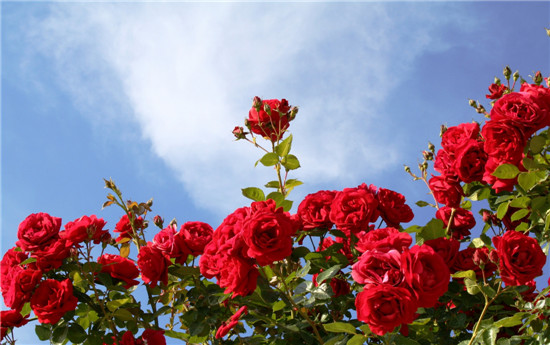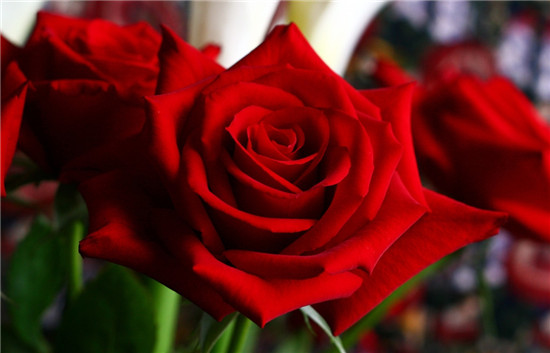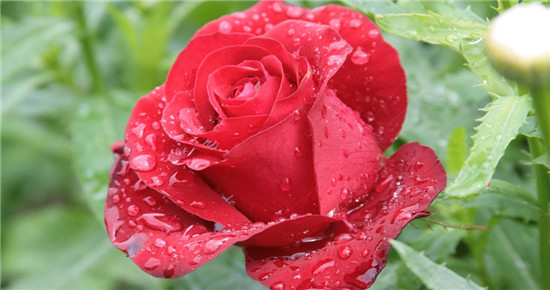The characteristics of roses detailed introduction of roses
Roses have the properties of cold resistance and temperature resistance, and the buds are fragrant and tender and moist, which is deeply loved by everyone, and it is also the best gift for girls. Next, let's learn about the characteristics of roses.

Roses are deciduous shrubs of the family Rosaceae, with purplish red flowers and fragrant smell. The biggest secret of Yang Guifei's ability to keep her skin tender and shiny is said to be soaked in fresh rosebuds all the year round in the Huaqing pool where she bathed. Rose petals can not only bathe but also skin care and beauty, is a natural beauty and skin care products.
In traditional Chinese medicine, aliases are lingering flowers, thorns and roses. Its nature is sweet and slightly bitter, warm and non-toxic. Enter the two meridians of liver and spleen. Efficacy: regulating qi and relieving depression, harmonizing blood and dispersing blood stasis. Main treatment of liver and stomach pain, new long wind arthralgia, hematemesis, irregular menstruation, red leucorrhea, dysentery, mastitis, swelling. "Food Materia Medica" refers to its "main benefit of the lungs and spleen, liver and gallbladder, the fragrance of the food is sweet and refreshing." This product can not only promote blood circulation and disperse stagnation, but also detoxify and detumescence, so it can eliminate facial acne and other diseases caused by endocrine dysfunction. Long-term use of this product, the beauty effect is very good, can effectively eliminate free radicals, eliminate pigmentation, arouse youthful vitality.

Morphological characteristics of Rose
Erect shrubs, up to 2 m tall; stems stout, tufted; branchlets densely tomentose with needles and glandular hairs, with erect or curved, yellowish prickles, tomentose outside prickles.
Leaflets 5-9 cm, petiole 5-13 cm long; leaflet elliptic or elliptic-Obovate, 1.5-4.5 cm long and 1-2.5 cm wide, apex acute or obtuse, base rounded or broadly cuneate, margin acutely serrate, dark green above, glabrous, veins sunken, wrinkled, gray-green below, midvein raised, reticulate veins obvious, densely tomentose and glandular hairy, sometimes inconspicuous glandular hairs Petiole and leaf rachis densely tomentose and glandular hairy; stipules mostly Adnate to petiole, free part ovate, margin glandular serrate, tomentose below.

The propagation of roses
The propagation is mainly ramet, and the sprouting tillers can be dug and planted around the bushes from defoliation to budding. It can also be propagated by cuttings, which can be inserted with semi-mature branches after flowering in the middle of June. After defoliation, it is necessary to dig trenches around the plant to apply base fertilizer, and apply fertilizer again when sprouting in early spring to promote the growth of branches and the prosperity of flowering. Roses are harmful to scale insects, aphids, red spiders and powdery mildew, which should be controlled as soon as possible. A renewal, rejuvenation and pruning should be carried out after four or five years of growth.

Flowers solitary in leaf axils, or several fascicled, bracts ovate, margin glandular hairy, outer tomentose; pedicel 5-22.5 mm long, densely tomentose and glandular hairy; flowers 4-5.5 cm in diameter; sepals ovate-lanceolate, apex caudate-acuminate, often with pinnate lobes spreading into leaves, sparsely pilose above, densely pilose and glandular hairy below; petals Obovate, double to semidouble, aromatic, fuchsia to white. Style free, hairy, slightly extending beyond the mouth of calyx tube, much shorter than stamens. Fruit oblate, 2-2.5 cm in diam., brick red, fleshy, smooth, sepals persistent. The flowering period is from May to June and the fruiting period is from August to September.
The above is my summary of the characteristics of roses, the full content of the detailed introduction of roses, I hope this article can help you. Please continue to follow us.
- Prev

How to cultivate four-season tangerine how to make bonsai of four-season orange
How to cultivate four-season tangerine how to make bonsai of four-season orange
- Next

How to cultivate butterfly orchids the cultivation methods of butterfly orchids
How to cultivate butterfly orchids the cultivation methods of butterfly orchids
Related
- Wuhan Hospital Iron Tree Blooming Result Was Instantly Frightened by the Gardener Master
- Which variety of camellia is the most fragrant and best? Which one do you like best?
- What is the small blue coat, the breeding methods and matters needing attention of the succulent plant
- Dormancy time and maintenance management of succulent plants during dormancy
- Minas succulent how to raise, Minas succulent plant pictures
- What are the varieties of winter succulent plants
- How to raise succulent plants in twelve rolls? let's take a look at some experience of breeding twelve rolls.
- Attention should be paid to water control for succulent plants during dormant period (winter and summer)
- Watering experience of twelve rolls of succulent plants
- Techniques for fertilizing succulent plants. An article will let you know how to fertilize succulent plants.

